1997 年 6 月英语四级真题及答案
Part I Listening Comprehension (20 minutes)
Section A
Directions: Inthissection,youwillhear10shortconversations.Attheendofeach
conversation, a question will be asked about what was said. Both the
conversationandthequestionwillbespokenonlyonce.Aftereachquestion
therewillbeapause.Duringthepause,youmustreadthefourchoicesmarked
A), B), C) and D), and decide which is the best answer. Then mark the
corresponding letter on the Answer Sheet with a single line through the
center.
Example:
You will hear:
You will read:
A) 2 hours.
B) 3 hours.
C) 4 hours.
D) 5 hours.
From the conversation we know that the two were talking about some work they will
start at 9 o’clock in the morning and have to finish at 2 in the afternoon. Therefore,
D) “5 hours” is the correct answer. You should choose [D] on the Answer Sheet and
mark it with a single line through the center.
Sample Answer [A] [B] [C] [D]
1.
A) Skating.
B) Swimming.
C) Boating and swimming.
D) Boating and skating.
2.
A) Put her report on his desk.
B) Read some papers he recommended.
C) Improve some parts of her paper.
D) Mail her report to the publisher.
3.
A) She takes it as a kind of exercise.
B) She wants to save money.
C) She loves doing anything that is new.
�
D) Her office isn’t very far.
4.
A) A shop assistant.
B) A telephone operator.
C) A waitress.
D) A clerk.
5.
A) A railway porter.
B) A taxi driver.
C) A bus conductor.
D) A postal clerk.
6.
A) Most people killed in traffic accidents are heavy drinkers.
B) She does not agree with the man.
C) Drunk drivers are not guilty.
D) People should pay more attention to the danger of drunk driving.
7.
A) $1.40.
B) $6.40.
C) $4.30.
D) $8.60.
8.
A) Collect papers for the man.
B) Do the typing once again.
C) Check the paper for typing errors.
D) Read the whole newspaper.
9.
A) The woman does not want to go to the movies.
B) The man is too tired to go to the movies.
C) The woman wants to go to the movies.
D) The man wants to go out for dinner.
10. A) By bus.
B) By bike.
C) By taxi.
D) On foot.
Section B Compound Dictation
Directions: Inthissection,youwillhearapassagethreetimes.Whenthepassageis
�
readforthefirsttime,youshouldlistencarefullyforitsgeneralidea.
Thenlistento thepassage again.Whenthe passageis read forthesecond
time, you are required to fill in the blanks numbered from S1 to S7 with
theexactworksyouhavejustheard.ForblanksnumberedfromS8toS10you
arerequiredtofillinthemissinginformation.Youcaneitherusetheexact
worksyouhavejustheardorwritedownthemainpointsinyourownwords.
Finally,whenthepassageisreadforthethirdtime,youshouldcheckwhat
you have written.
In police work, you can never predict the next crime or problem. No working day
is identical to any other, so there is no “(S1) ________” day for a police officer.
Some days are (S2) ________ slow, and the job is (S3) ________; other days are so busy
that there is no time to eat. I think I can (S4) ________ police work in one word: (S5)
________. Sometimes it’s dangerous. One day, for example, I was working undercover;
that is, I was on the job, but I was wearing (S6) ________ clothes, not my police (S7)
________. I was trying to catch some robbers who were stealing money from people as
they walked down the street. Suddenly, (S8) ________. Another policeman arrived, and
together, we arrested three of the men; but the other four ran away. Another day, I
helped a woman who was going to have a baby. (S9) ________. I put her in my police car
to get her there faster. I thought she was going to have the baby right there in my
car. But fortunately, (S10) ________.
Part II Reading Comprehension (35 minutes)
Directions: There are 4 passages in this part. Each passage is followed by some
questionsorunfinishedstatements.Foreachofthemtherearefourchoices
markedA),B),C)andD).Youshoulddecideonthebestchoiceandmarkthe
corresponding letter on the Answer Sheet with a single line through the
center.
Passage One
Questions 11 to 15 are based on the following passage.
The fridge is considered a necessity. It has been so since the 1960s when packaged
food first appeared with the label: “store in the refrigerator.”
In my fridgeless Fifties childhood, I was fed well and healthy. The milkman came
daily, the grocer, the butcher (肉商), the baker, and the ice-cream man delivered two
or three times a week. The Sunday meat would last until Wednesday and surplus (剩余
的) bread and milk became all kinds of cakes. Nothing was wasted, and we were never
troubled by rotten food. Thirty years on, food deliveries have ceased, fresh vegetables
are almost unobtainable in the country.
The invention of the fridge contributed comparatively little to the art of food
preservation. A vast way of well-tried techniques already existed-natural cooling,
drying, smoking, salting, sugaring, bottling...
What refrigeration did promote was marketing—marketing hardware and electricity,
�
marketing soft drinks, marketing dead bodies of animals around the globe in search of
a good price.
Consequently, most of the world’s fridges are to be found, not in the tropics where
they might prove useful, but in the wealthy countries with mild temperatures where they
are climatically almost unnecessary. Every winter, millions of fridges hum away
continuously, and at vast expense, busily maintaining an artificially-cooled space
inside an artificially-heated house-while outside, nature provides the desired
temperature free of charge.
The fridge’s effect upon the environment has been evident, while its contribution
to human happiness has been insignificant. If you don’t believe me, try it yourself,
invest in a food cabinet and turn off your fridge next winter. You may miss the hamburgers
(汉堡包), but at least you’ll get rid of that terrible hum.
11. The statement “In my fridgeless Fifties childhood, I was fed well and healthily.”
(Line 1, Para. 2) suggests that ________.
A) the author was well-fed and healthy even without a fridge in his fifties
B) the author was not accustomed to using fridges even in his fifties
C) there was no fridge in the author’s home in the 1950s
D) the fridge was in its early stage of development in the 1950s
12. Why does the author say that nothing was wasted before the invention of fridges?
A) People would not buy more food than was necessary.
B) Food was delivered to people two or three times a week.
C) Food was sold fresh and did not get rotten easily.
D) People had effective ways to preserve their food.
13. Who benefited the least from fridges according to the author?
A) Inventors.
B) Consumers.
C) Manufacturers.
D) Traveling salesmen.
14. Which of the following phrases in the fifth paragraph indicates the fridge’s
negative effect on the environment?
A) “Hum away continuously”.
B) “Climatically almost unnecessary”.
C) “Artificially-cooled space”.
D) “With mild temperatures”.
15. What is the author’s overall attitude toward fridges?
�
A) Neutral.
B) Critical.
C) Objective.
D) Compromising.
Passage Two
Questions 16 to 20 are based on the following passage.
The human brain contains 10 thousand million cells and each of these may have a
thousand connections. Such enormous numbers used to discourage us and cause us to
dismiss the possibility of making a machine with human-like ability, but now that we
have grown used to moving forward at such a pace we can be less sure. Quite soon, in
only 10 or 20 years perhaps, we will be able to assemble a machine as complex as the
human brain, and if we can we will. It may then take us a long time to render it
intelligent by loading in the right software (软件) or by altering the architecture
but that too will happen.
I think it certain that in decades, not centuries, machines of silicon (硅) will
arise first to rival and then exceed their human ancestors. Once they exceed us they
will be capable of their own design. In a real sense they will be able to reproduce
themselves. Silicon will have ended carbon’s long control. And we will no longer be
able to claim ourselves to be the finest intelligence in the known universe.
As the intelligence of robots increases to match that of humans and as their cost
declines through economies of scale we may use them to expand our frontiers, first on
earth through their ability to withstand environments, harmful to ourselves. Thus,
deserts may bloom and the ocean beds be mined. Further ahead, by a combination of the
great wealth this new age will bring and the technology it will provide, the construction
of a vast, man-created world in space, home to thousands or millions of people, will
be within our power.
16. In what way can we make a machine intelligent?
A) By making it work in such environments as deserts, oceans or space.
B) By working hard for 10 or 20 years.
C) By either properly programming it or changing its structure.
D) By reproducing it.
17. What does the writer think about machines with human-like ability?
A) He believes they will be useful to human beings.
B) He believes that they will control us in the future.
C) He is not quite sure in what way they may influence us.
D) He doesn’t consider the construction of such machines possible.
�
18. The word “carbon” (Line 4, Para. 2) stands for ________.
A) intelligent robots
B) a chemical element
C) an organic substance
D) human beings
19. A robot can be used to expand our frontiers when ________.
A) its intelligence and cost are beyond question
B) it is able to bear the rough environment
C) it is made as complex as the human brain
D) its architecture is different from that of the present ones
20. It can be inferred from the passage that ________.
A) after the installation of a great number of cells and connections, robots will
be capable of self-reproduction
B) with the rapid development of technology, people have come to realize the
possibility of making a machine with human-like ability
C) once we make a machine as complex as the human brain, it will posses intelligence
D) robots will have control of the vast, man-made world in space
Passage Three
Questions 21 to 25 are based on the following passage.
After the violent earthquake that shook Los Angeles in 1994, earthquake scientists
had good news to report: The damage and deathtoll(死亡人数) could have been much worse.
More than 60 people died in this earthquake. By comparison, as earthquake of similar
intensity that shook America in 1988 claimed 25,000 victims.
Injuries and deaths were relatively less in Los Angeles because the quake occurred
at 4:31 a.m. on a holiday, when traffic was light on the city’s highways. In addition,
changes made to the construction codes in Los Angeles during the last 20 years have
strengthened the city’s buildings and highways, making them more resistant to quakes.
Despite the good new, civil engineers aren’t resting on their successes. Pinned
to their drawing boards are blueprints(蓝图) for improved quake-resistant buildings.
The new designs should offer even greater security to cities where earthquakes often
take place.
In the past, making structures quake-resistant meant firm yet flexible materials,
such as steel and wood, that bend without breaking. Later, people tried to lift a
building off its foundation, and insert rubber and steel between the building and its
foundation to reduce the impact of ground vibrations. The most recent designs give
buildings brains as well as concrete and steel supports. Called smart buildings, the
�
structures respond like living organisms to an earthquake’s vibrations. When the
ground shakes and the building tips forward, the computer would force the building to
shift in the opposite direction.
The new smart structures could be very expensive to build. However, they would save
many lives and would be less likely to be damaged during earthquakes.
21. One reason why the loss of lives in the Los Angeles earthquake was comparatively
low is that ________.
A) new computers had been installed in the buildings
B) it occurred in the residential areas rather than on the highways
C) large numbers of Los Angeles residents had gone for a holiday
D) improvements had been made in the construction of buildings and highways
22. The function of the computer mentioned in the passage is to ________.
A) counterbalance an earthquake’s action on the building
B) predict the coming of an earthquake with accuracy
C) help strengthen the foundation of the building
D) measure the impact of an earthquake’s vibrations
23. The smart buildings discussed in the passage ________.
A) would cause serious financial problems
B) would be worthwhile though costly
C) would increase the complexity of architectural design
D) can reduce the ground vibrations caused by earthquakes
24. It can be inferred from the passage that in minimizing the damage caused by
earthquakes attention should be focused on ________.
A) the increasing use of rubber and steel in capital construction
B) the development of flexible building materials
C) the reduction of the impact of ground vibrations
D) early forecasts of earthquakes
25. The author’s main purpose in writing the passage is to ________.
A) compare the consequences of the earthquakes that occurred in the U.S.
B) encourage civil engineers to make more extensive use of computers
C) outline the history of the development of quake-resistant building materials
D) report new developments in constructing quake-resistant buildings
Passage Four
�
Questions 26 to 30 are based on the following passage.
Even plants can run a fever, especially when they’re under attack by insects or
disease. But unlike humans, plants can have their temperature taken from 3,000 feet
away-straight up. A decade ago, adapting the infrared (红外线) scanning technology
developed for military purposes and other satellites, physicist Stephen Paley came up
with a quick way to take the temperature of crops to determine which ones are under
stress. The goal was to let farmers precisely target pesticide(杀虫剂) spraying rather
than rain poison on a whole field, which invariably includes plants that don’t have
pest (害虫) problems.
Even better, Paley’s Remote Scanning Services Company could detect crop problems
before they became visible to the eye. Mounted on a plane flown at 3,000 feet at night,
an infrared scanner measured the heat emitted by crops. The data were transformed into
a color-coded map showing where plants were running “fevers”. Farmers could then
spot-spray, using 50 to 70 percent less pesticide than they otherwise would.
The bad news is that Paley’s company closed down in 1984, after only three years.
Farmers resisted the new technology and long-term backers were hard to find. But with
the renewed concern about pesticides on produce, and refinements in infrared scanning,
Paley hopes to get back into operation. Agriculture experts have no doubt the technology
works. “This technique can be used on 75 percent of agricultural land in the United
States,” says George Oerther of Texas A&M. Ray Jackson, who recently retired from the
Department of Agriculture, thinks remote infrared crop scanning could be adopted by
the end of the decade. But only if Paley finds the financial backing which he failed
to obtain 10 years ago.
26. Plants will emit an increased amount of heat when they are ________.
A) sprayed with pesticides
B) facing an infrared scanner
C) in poor physical condition
D) exposed to excessive sun rays
27. In order to apply pesticide spraying precisely, we can use infrared scanning to
________.
A) estimate the damage to the crops
B) draw a color-coded map
C) measure the size of the affected area
D) locate the problem area
28. Farmers can save a considerable amount of pesticide by ________.
A) resorting to spot-spraying
B) consulting infrared scanning experts
C) transforming poisoned rain
�

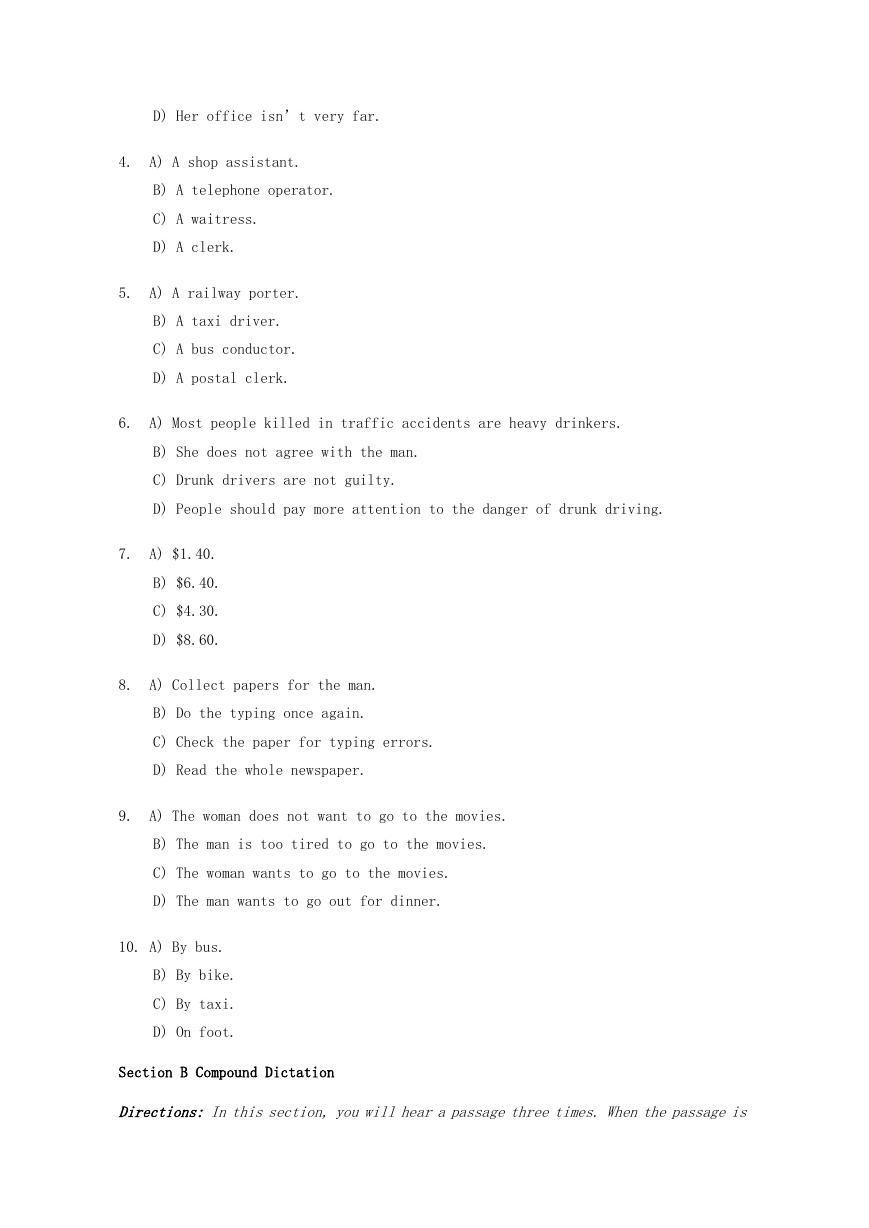

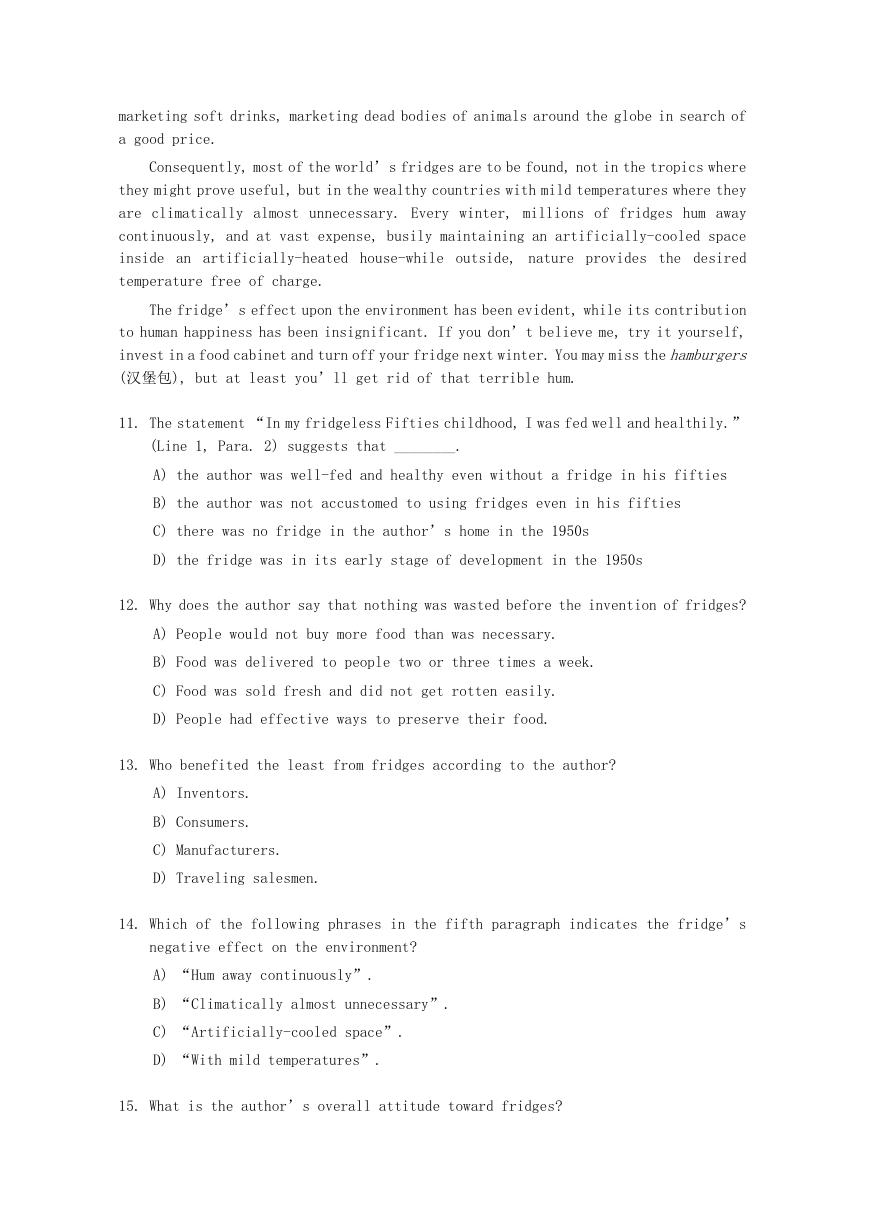
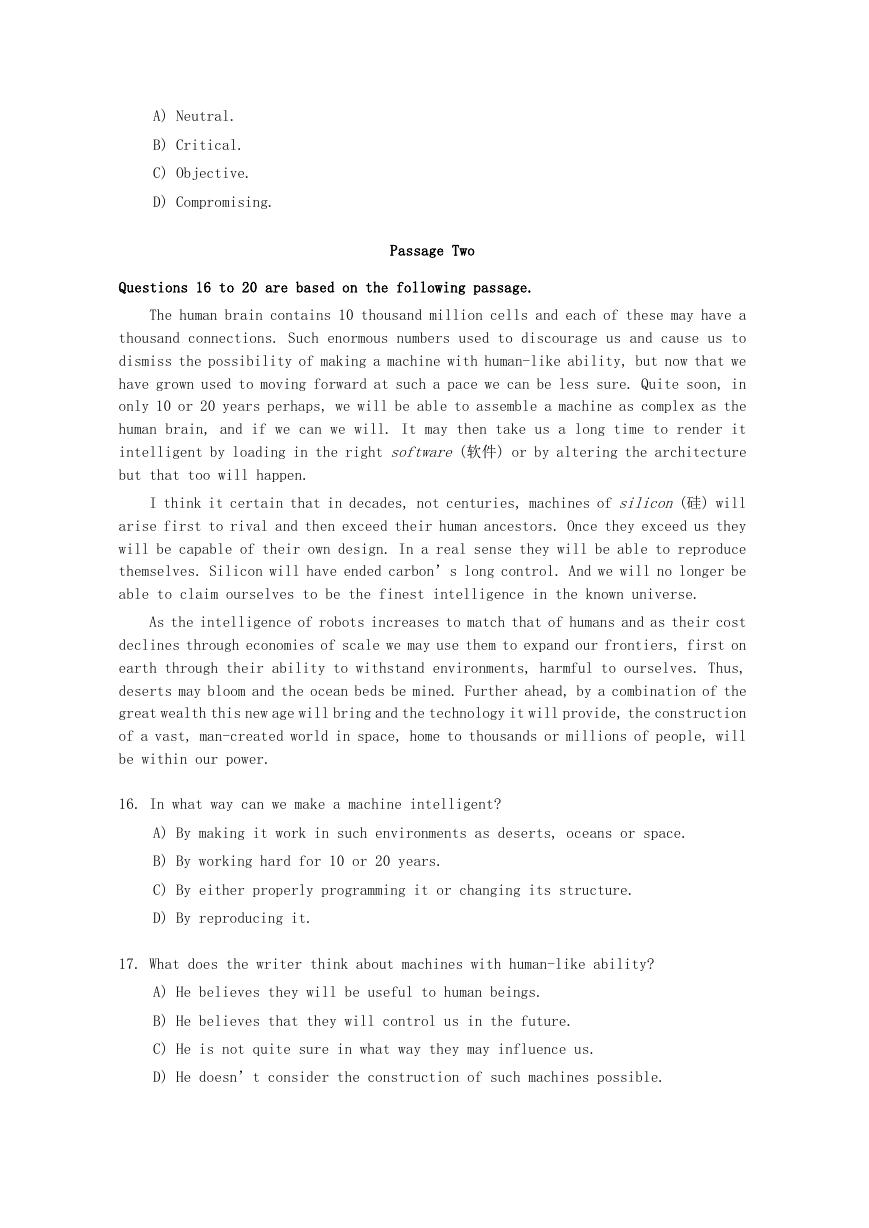
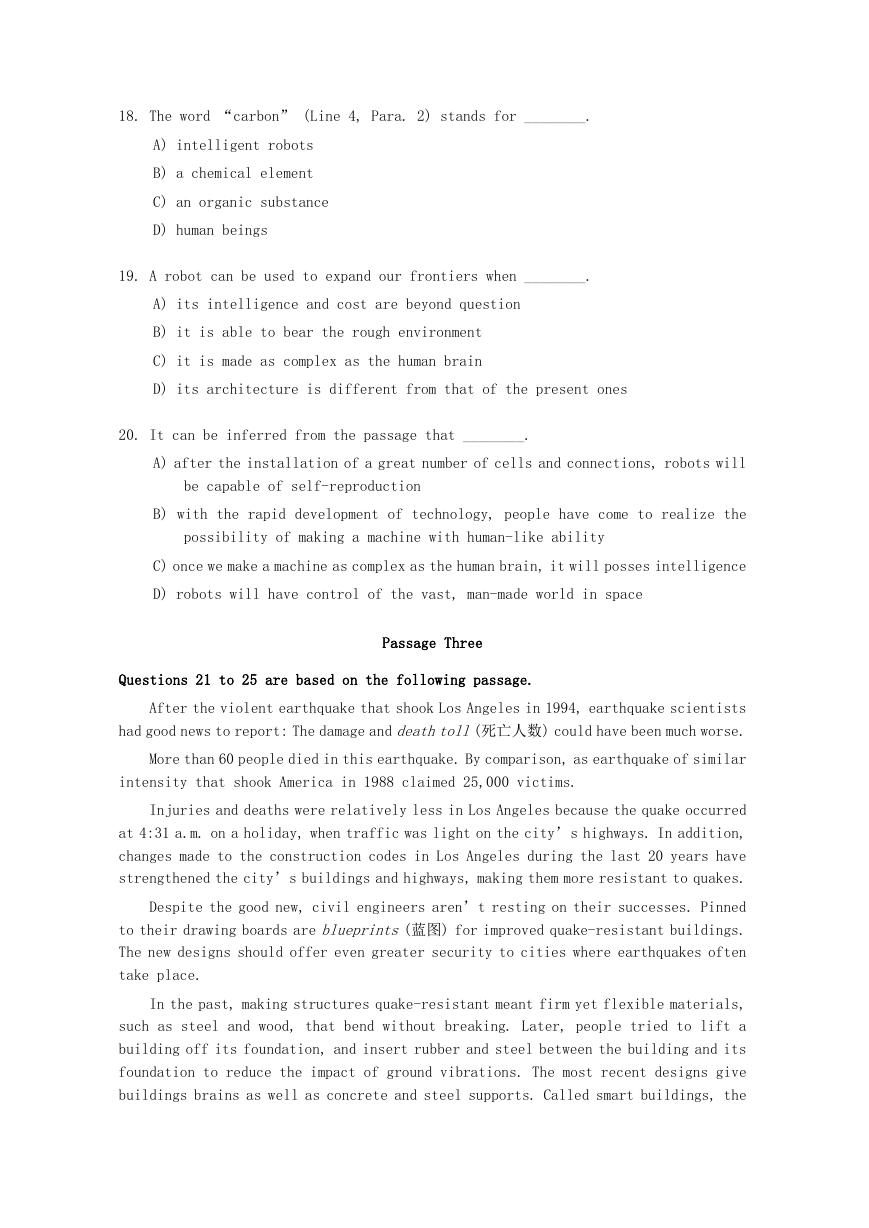
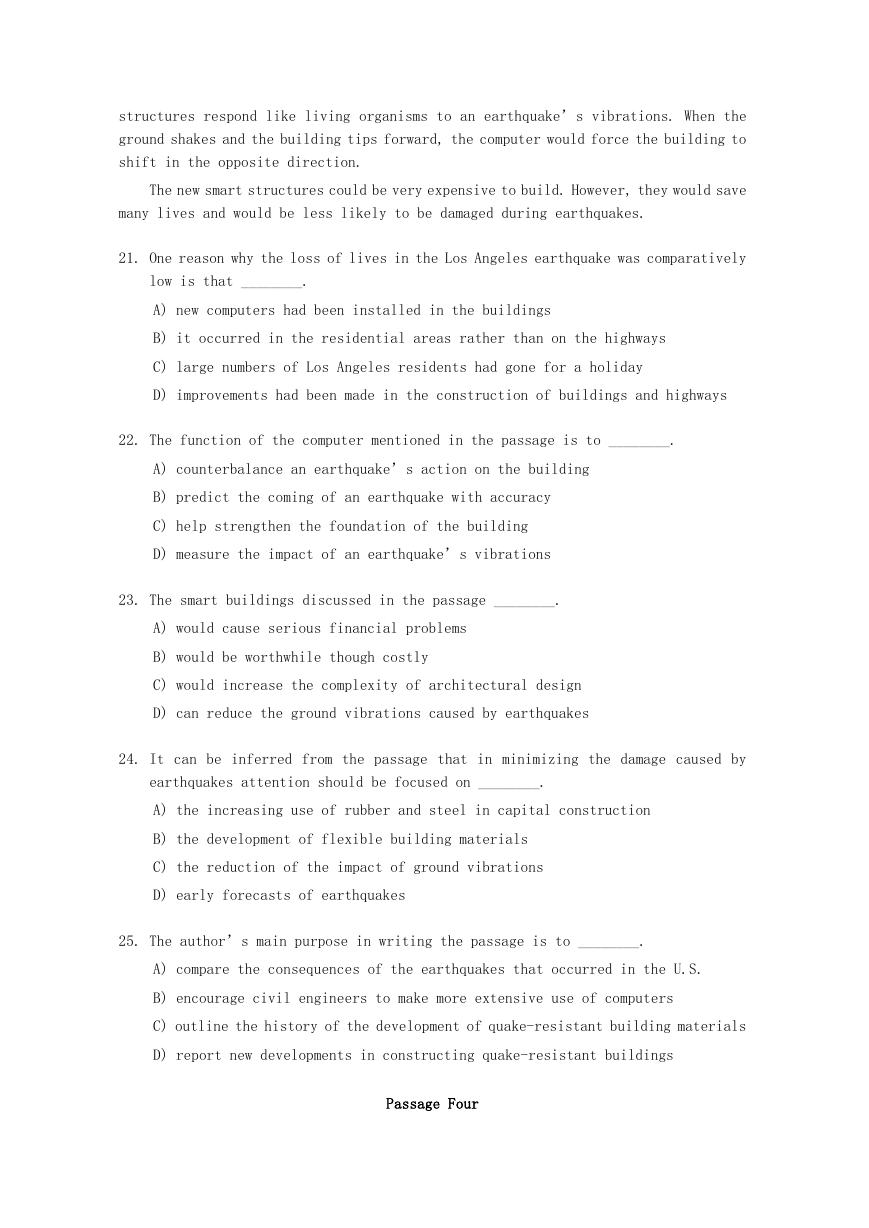
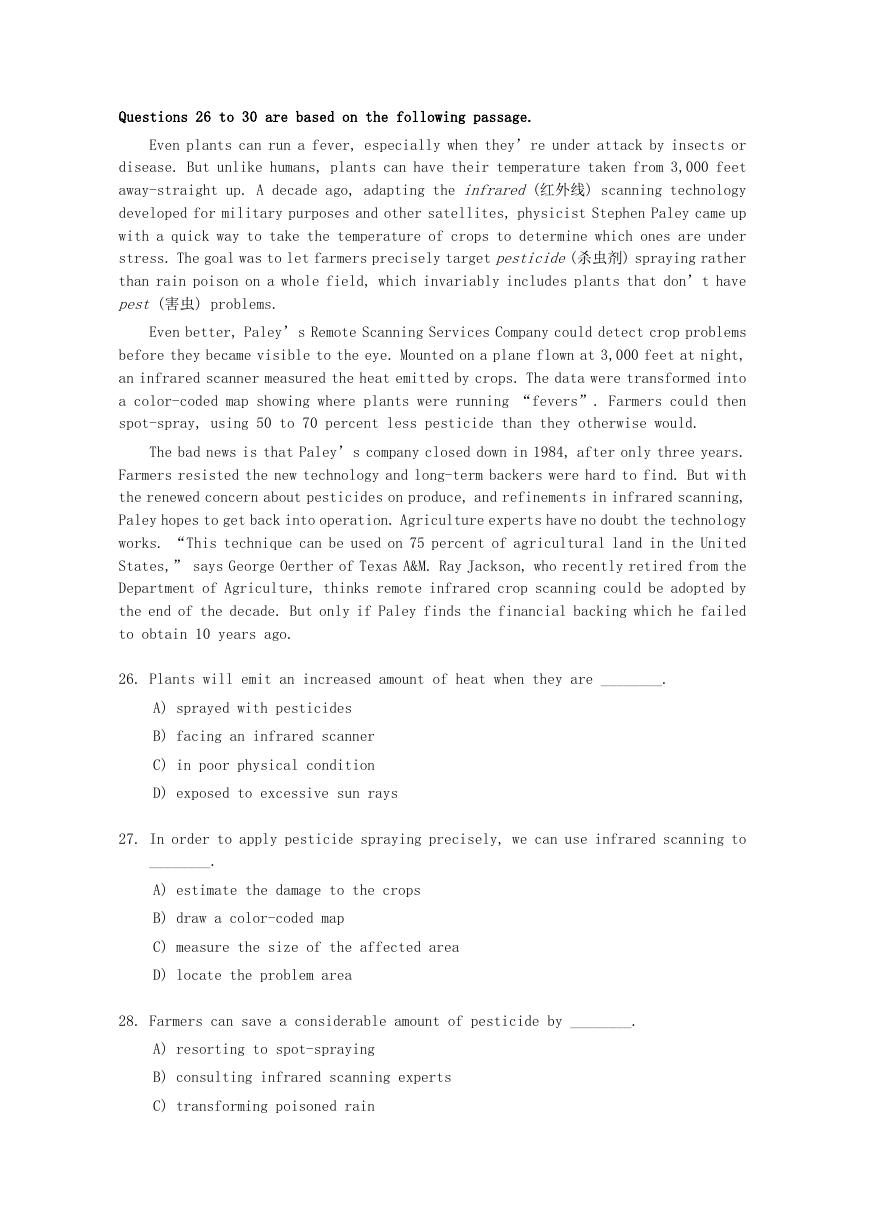








 2023年江西萍乡中考道德与法治真题及答案.doc
2023年江西萍乡中考道德与法治真题及答案.doc 2012年重庆南川中考生物真题及答案.doc
2012年重庆南川中考生物真题及答案.doc 2013年江西师范大学地理学综合及文艺理论基础考研真题.doc
2013年江西师范大学地理学综合及文艺理论基础考研真题.doc 2020年四川甘孜小升初语文真题及答案I卷.doc
2020年四川甘孜小升初语文真题及答案I卷.doc 2020年注册岩土工程师专业基础考试真题及答案.doc
2020年注册岩土工程师专业基础考试真题及答案.doc 2023-2024学年福建省厦门市九年级上学期数学月考试题及答案.doc
2023-2024学年福建省厦门市九年级上学期数学月考试题及答案.doc 2021-2022学年辽宁省沈阳市大东区九年级上学期语文期末试题及答案.doc
2021-2022学年辽宁省沈阳市大东区九年级上学期语文期末试题及答案.doc 2022-2023学年北京东城区初三第一学期物理期末试卷及答案.doc
2022-2023学年北京东城区初三第一学期物理期末试卷及答案.doc 2018上半年江西教师资格初中地理学科知识与教学能力真题及答案.doc
2018上半年江西教师资格初中地理学科知识与教学能力真题及答案.doc 2012年河北国家公务员申论考试真题及答案-省级.doc
2012年河北国家公务员申论考试真题及答案-省级.doc 2020-2021学年江苏省扬州市江都区邵樊片九年级上学期数学第一次质量检测试题及答案.doc
2020-2021学年江苏省扬州市江都区邵樊片九年级上学期数学第一次质量检测试题及答案.doc 2022下半年黑龙江教师资格证中学综合素质真题及答案.doc
2022下半年黑龙江教师资格证中学综合素质真题及答案.doc